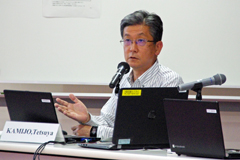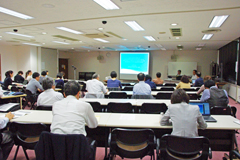JICA-RI Researcher Tetsuya Kamijo Discusses Improving the Quality of Environmental and Social Considerations
2017.06.27
Tetsuya Kamijo of the JICA Research Institute presented the results of his research on improving the quality of environmental impact assessment reports and the effectiveness of alternatives analysis and public involvement, at a seminar held at the JICA Research Institute in Tokyo, on June 13, 2017.
He explained his research, which examined ways to improve the quality of environmental impact assessment reports. His research analyzed the quality of 120 environmental impact assessment reports prepared by JICA, randomly selected from 2001 to 2012, to see whether the introduction of JICA guidelines for environmental and social considerations in 2004 had any effect on the quality of those reports. He indicated that an effect of JICA guidelines could be seen, since quality was found to significantly improve after 2005.

JICA-RI researcher Tetsuya Kamijo gave a presenation
His research found a causal link between the main variables and the overall quality of reports, and he explained the effects of alternatives analysis and public involvement in improving quality. By pointing out that alternatives analysis is a very important process but in itself has no effect, he argued that public involvement may increase the environmental and social awareness of project proponents. He pointed out the linkage between alternatives analysis and public involvement was a key factor for improving report quality.
Next, he moved on to another analysis, which examined the discussion of alternatives and public involvement.
He explained the results obtained from quantitative text analysis of the minutes of meetings of three projects: (1) an airport project in Guatemala, (2) a road project in the Philippines, and (3) a bridge project in Cambodia. The reports of these projects were prepared in 2006. He showed the number of paragraphs per stakeholder, according to the five coding rules: environmental issues, social issues, development issues, alternatives, and sense of public involvement. He pointed out that enhancing the discussion of alternatives may lead to improved public involvement, because a positive correlation was recognized between the two, and he proposed the use of principle component analysis as a method of alternatives analysis to enhance the discussion of alternatives.

The seminar attracted environmental assessment practitioners and researchers
The seminar attracted around 35 participants, including environmental assessment practitioners and researchers. Some said that they found the analysis of the introductory effects of the guidelines and factors that improve report quality useful for their work. Others said that it was not easy in practice to consider a wide range of alternatives. Participants expressed the expectation that further analysis would be conducted using data on report quality from 2013 to 2016.

事業事前評価表(地球規模課題対応国際科学技術協力(SATREPS)).国際協力機構 地球環境部 . 防災第一チーム. 1.案件名.国 名: フィリピン共和国.

事業事前評価表(地球規模課題対応国際科学技術協力(SATREPS)).国際協力機構 地球環境部 . 防災第一チーム. 1.案件名.国 名: フィリピン共和国.

事業事前評価表(地球規模課題対応国際科学技術協力(SATREPS)).国際協力機構 地球環境部 . 防災第一チーム. 1.案件名.国 名: フィリピン共和国.

事業事前評価表(地球規模課題対応国際科学技術協力(SATREPS)).国際協力機構 地球環境部 . 防災第一チーム. 1.案件名.国 名: フィリピン共和国.

事業事前評価表(地球規模課題対応国際科学技術協力(SATREPS)).国際協力機構 地球環境部 . 防災第一チーム. 1.案件名.国 名: フィリピン共和国.
scroll